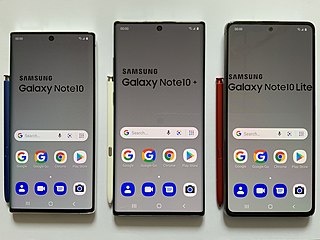 W
WMobile computing is human–computer interaction in which a computer is expected to be transported during normal usage, which allows for the transmission of data, voice, and video. Mobile computing involves mobile communication, mobile hardware, and mobile software. Communication issues include ad hoc networks and infrastructure networks as well as communication properties, protocols, data formats, and concrete technologies. Hardware includes mobile devices or device components. Mobile software deals with the characteristics and requirements of mobile applications.
 W
WA barcode system is a network of hardware and software, consisting primarily of mobile computers, printers, handheld scanners, infrastructure, and supporting software. Barcode systems are used to automate data collection where hand recording is neither timely or cost effective. Barcoding systems are not radio-frequency identification (RFID) systems even though the companies that provide barcode equipment will often also provide RFID equipment and many companies use both technologies as part of larger resource management systems.
 W
WThe BlackDog is a pocket-sized, self-contained computer with a built-in biometric fingerprint reader which was developed in 2005 by Realm Systems, which is plugged into and powered by the USB port of a host computer using its peripheral devices for input and output.
 W
WA carputer is a computer with specializations to run in a car, such as compact size, low power requirement, and some customized components. The actual computing hardware is typically based on standard PCs or mobile devices. Because they are computer based they typically have many standard interfaces such as Bluetooth, USB, and WiFi. The first carputer was introduced by Clarion Co. on December 4, 1998, although on-board diagnostics have already been employed ever since the 1980s in order to measure precisely the amount of fuel entering the engine as the carburetors got too complex.
 W
WAn electronic organizer is a small calculator-sized computer, often with an built-in diary application and other functions such as an address book and calendar. It normally has a small alphanumeric keypad and an LCD screen of one, two, or three lines. The electronic diary or organizer was invented by an Indian businessman Satyan Pitroda in 1975. He is regarded as one of the earliest pioneers of hand-held computing because of his invention of the Electronic Diary in 1975.
 W
WThe Ferranti Market Research Terminal (MRT) was, arguably, the world’s first application-specific handheld computer. It was designed specifically for the market research sector as a means to augment the regular clipboard schemes that, at the time, were common-place, in social and market research. Despite having an appearance of a calculator built into a clipboard, the reality was that the unit contained a sophisticated form of programmable data-logger that, in response to an interviewer reading questions to the interviewee, had answers digitally recorded via pressing appropriate keys on the unit. The unit contained a bespoke operating system to support field based market research. The Ferranti Market Research Terminal (MRT) is also of historical significance to the computing industry since it marked the last original computer design from Ferranti, a long established business that had risen to fame through a collaboration Manchester University to produce the "Mark 1", the world’s first commercial computer and later with Cambridge University producing the "Atlas" and "Titan" computers which, at their peak, held around 25% of the computing market.
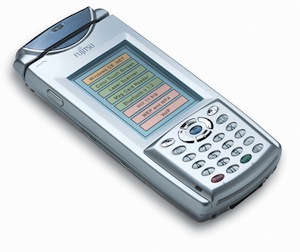 W
WThe Fujitsu iPAD is a lightweight handheld device that was introduced by Fujitsu, in 2002. It runs Microsoft's CE.NET operating system. It supports 802.11b wireless LAN to connect wirelessly with other company infrastructure. The device can support inventory management as well as credit card payments. In January 2010, when Apple announced the Apple iPad, there was a naming controversy between the two devices. To settle the trademark infringement allegation, Apple purchased the trademark rights from Fujitsu. Some trademark analysts estimate that Apple paid Fujitsu over US$4 million in exchange for the March 17, 2010 assignment of Fujitsu's iPad trademark rights to Apple.
 W
WGPD Win is a Windows-based handheld computer equipped with a keyboard and gaming controls. It is an x86-based device which runs a full version of Windows 10 Home. The device was envisioned primarily with video game console emulation and PC gaming in mind, but is capable of running any x86 Windows-based application that can run within the confines of the computer's technical specifications. First announced in October 2015, it was crowdfunded via Indiegogo and two other crowdfunding sites in Japan and China, and was released in October 2016.
 W
WThe GPD Win 2 is a Windows-based handheld computer that is the successor to the GPD Win. It is manufactured by Chinese company GamePad Digital, and crowdfunded just as its predecessor was. Announced in first-quarter 2017, the crowdfunding campaign officially kicked off on January 15, 2018, and quickly surpassed its goal. Within days, it reached $1.8 million USD funding off of a stated $100,000 goal. It was released in May 2018.
 W
WA handheld PC is the term for miniature computers typically built around a clamshell form factor and is significantly smaller than any standard laptop computer, but based on the same principles. It is sometimes referred to as a palmtop computer, not to be confused with Palmtop PC which was a name used mainly by Hewlett-Packard.
 W
WHanging with Friends is a defunct multi-player word game developed by Zynga with Friends, which also developed Words with Friends. Players took turns guessing words, similar to Hangman, with either friends or random opponents. Released by Zynga in June 2011, the game was available for cross-platform play on iPhone and Android.
 W
WThe HP Compaq TC1100 is a tablet PC sold by Hewlett-Packard that was the follow-up to the Compaq TC1000. The TC1100 had either an Intel Celeron or an Intel Pentium M chip set and could be upgraded up to 2 gigabytes of memory. The switch from Transmeta Crusoe processors to the Pentium M and the ability to add memory was welcomed after numerous complaints about the poor performance of the TC1000. The TC1100 was the last version from HP in this style of tablet. It was replaced by the HP Compaq TC4200, which featured a more traditional one-piece design.
 W
WHTC Shift is an Ultra-Mobile PC by HTC.
 W
WThe iPAQ is a Pocket PC and personal digital assistant, first unveiled by Compaq in April 2000; the name was borrowed from Compaq's earlier iPAQ Desktop Personal Computers. Since Hewlett-Packard's acquisition of Compaq, the product has been marketed by HP. The devices use a Windows Mobile interface. In addition to this, there are several Linux distributions that will also operate on some of these devices. Earlier units were modular. "Sleeve" accessories, technically called jackets, which slide around the unit and add functionality such as a card reader, wireless networking, GPS, and even extra batteries were used. Later versions of iPAQs have most of these features integrated into the base device itself, some including GPRS mobile-telephony.
 W
WThe Jornada was a line of personal digital assistants or PDAs manufactured by Hewlett-Packard. The Jornada was a broad product line that included Palm-Size PCs, Handheld PCs, and Pocket PCs. The first model was the 820, released in 1998, and the last was the 928 model in 2002 when Compaq and HP merged. The Jornada line was then succeeded by the more popular iPAQ model PDAs. All Jornada models ran Microsoft Operating Systems that were based on Windows CE.
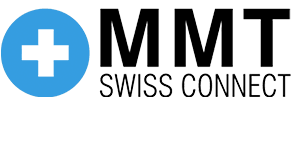 W
WManufacture Modules Technologies Sarl (MMT) is a Swiss company established in Geneva in 2015 which originally specialised in the development and commercialization of "Horological Smartwatch modules", firmware, apps and cloud. Located at Geneva's Skylab high-tech hub, it expanded into the development and manufacturing of "E-Straps" operated with a mobile application.
 W
WThe notion of making media mobile can be traced back to the “first time someone thought to write on a tablet that could be lifted and hauled – rather than on a cave wall, a cliff face, a monument that usually was stuck in place, more or less forever”. In his book Cellphone, Paul Levinson refers to mobile media as “the media-in-motion business.” Since their incarnation, mobile phones as a means of communication have been a focus of great fascination as well as debate. In the book, Studying Mobile Media: Cultural Technologies, Mobile Communication, and the iPhone, Gerard Goggin notes how the ability of portable voice communication to provide ceaseless contact complicates the relationship between the public and private spheres of society. Lee Humphrey's explains in her book that now, "more people in the world today have a mobile phone than have an Internet connection".
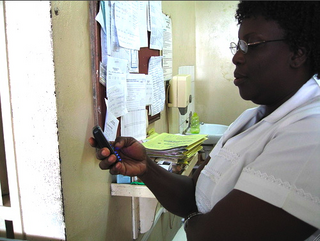 W
WmHealth is an abbreviation for mobile health, a term used for the practice of medicine and public health supported by mobile devices. The term is most commonly used in reference to using mobile communication devices, such as mobile phones, tablet computers and personal digital assistants (PDAs), and wearable devices such as smart watches, for health services, information, and data collection. The mHealth field has emerged as a sub-segment of eHealth, the use of information and communication technology (ICT), such as computers, mobile phones, communications satellite, patient monitors, etc., for health services and information. mHealth applications include the use of mobile devices in collecting community and clinical health data, delivery/sharing of healthcare information for practitioners, researchers and patients, real-time monitoring of patient vital signs, the direct provision of care as well as training and collaboration of health workers.
 W
WA mobile device is a computer small enough to hold and operate in the hand. Typically, any handheld computer device will have an LCD or OLED flatscreen interface, providing a touchscreen interface with digital buttons and keyboard or physical buttons along with a physical keyboard. Many such devices can connect to the Internet and interconnect with other devices such as car entertainment systems or headsets via Wi-Fi, Bluetooth, cellular networks or near field communication (NFC). Integrated cameras, the ability to place and receive voice and video telephone calls, video games, and Global Positioning System (GPS) capabilities are common. Power is typically provided by a lithium-ion battery. Mobile devices may run mobile operating systems that allow third-party apps specialized for said capabilities to be installed and run.
 W
WMobile device forensics is a branch of digital forensics relating to recovery of digital evidence or data from a mobile device under forensically sound conditions. The phrase mobile device usually refers to mobile phones; however, it can also relate to any digital device that has both internal memory and communication ability, including PDA devices, GPS devices and tablet computers.
 W
Wmobile Internet device (MID) is a multimediacapable mobile device providing wireless Internet access. They are designed to provide entertainment, information and location-based services for personal or business use. They allow 2-way communication and real-time sharing. They have been described as filling a niche between smartphones and tablet computers.
 W
WMobile-ITX is the smallest x86 compliant motherboard form factor presented by VIA Technologies in December, 2009. The motherboard size is 60 × 60 mm (2.4 × 2.4 in). There are no computer ports on the CPU module and it is necessary to use an I/O carrier board. The design is intended for medical, transportation and military embedded markets.
 W
WThe MobilePro is a discontinued line of personal digital assistants manufactured by NEC. Most models in the MobilePro range were handheld PCs with almost full size keyboards and a compact form placing them between being a palmtop and a subnotebook. All of the models in the MobilePro range ran a version of Microsoft's Windows CE mobile operating system and could be navigated using a stylus and touchscreen.
 W
WThe Noahpad is a Netbook developed by the Taiwanese company E-Lead. This small laptop shares some similar characteristics with other Netbooks launched in 2007, like the ASUS Eee PC, the OLPC and the Classmate PC.
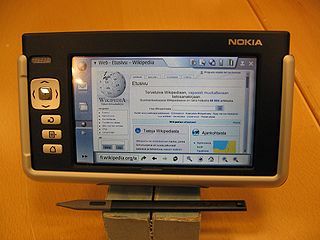 W
WThe Nokia 770 Internet Tablet is a wireless Internet appliance from Nokia, originally announced at the LinuxWorld Summit in New York City on 25 May 2005. It is designed for wireless Internet browsing and e-mail functions and includes software such as Internet radio, an RSS news reader, ebook reader, image viewer and media players for selected types of media.
 W
WThe Nokia N800 Internet tablet is a wireless Internet appliance from Nokia, originally announced at the Las Vegas CES 2007 Summit in January 2007. N800 allows the user to browse the Internet and communicate using Wi-Fi networks or with mobile phone via Bluetooth. The N800 was developed as the successor to the Nokia 770. It includes FM and Internet radio, an RSS news reader, image viewer and a media player for audio and video files.
 W
WThe Nokia N810 Internet tablet is an Internet appliance from Nokia, announced on 17 October 2007 at the Web 2.0 Summit in San Francisco. Despite Nokia's strong association with cellular products, the N810, like preceding tablets produced by Nokia, was not a phone, but instead allowed the user to browse the Internet and communicate using Wi-Fi networks or with a mobile phone via Bluetooth. It built on the hardware and software of the Nokia N800 with some features added and some removed.
 W
WThe NOVO7 is a series of Android tablet computers manufactured by the Chinese company Ainol Electronics. The "7" represents the size of the tablet's screen ; Ainol's other products include the Novo 5 and Novo 8.
 W
WThe OLPC XO, previously known as the $100 Laptop, Children's Machine, and 2B1, is an inexpensive laptop computer intended to be distributed to children in developing countries around the world, to provide them with access to knowledge, and opportunities to "explore, experiment and express themselves". The XO was developed by Nicholas Negroponte, a co-founder of MIT's Media Lab, and designed by Yves Behar's Fuseproject company. The laptop is manufactured by Quanta Computer and developed by One Laptop per Child (OLPC), a non-profit 501(c)(3) organization.
 W
WThe Palm Foleo was a planned subnotebook computer that was announced by mobile device manufacturer Palm Inc. on May 30, 2007, and canceled three months later. It intended to serve as a companion for smartphones including Palm's own Treo line. The device ran on the Linux operating system and featured 256 MB of flash memory and an immediate boot-up feature.
 W
WA Palmtop PC was an approximately pocket calculator-sized, battery-powered computer compatible with the IBM Personal Computer in a horizontal clamshell design with integrated keyboard and display. It could be used like a subnotebook, but was light enough to be comfortably used handheld as well. Most Palmtop PCs were small enough to be stored in a user's shirt or jacket pocket.
 W
WPeek Inc. was a mobile technology company headquartered in New York, NY. The company's roots were with its mobile Internet device, a low-cost email-only mobile handheld device launched in September 2008.
 W
WThe Pepper Pad was a family of Linux-based mobile computers with Internet capability and which doubled as a handheld game console. They also served as a portable multimedia device. The devices used Bluetooth and Wi-Fi technologies for Internet connection. Pepper Pads are now obsolete, unsupported and the parent company has ceased operations.
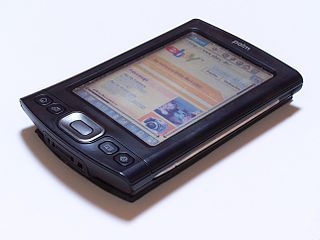 W
WA personal digital assistant (PDA), also known as a handheld PC, is a variety mobile device which functions as a personal information manager. PDAs have been mostly displaced by the widespread adoption of highly capable smartphones, in particular those based on iOS and Android.
 W
WThe Personal Internet Communicator (PIC) is a consumer device released by AMD in 2004 to allow people in emerging countries like India, Uruguay and the Caribbean access to the internet. Originally part of AMD's 50x15 Initiative, the PIC has been deployed by Internet service providers (ISPs) in several developing countries. It is based on an AMD Geode CPU and uses Microsoft Windows CE and Microsoft Internet Explorer 6.
 W
WThe Philips Nino was a so-called Palm-size PC, a predecessor to the Pocket PC platform. It was a PDA-style device with a stylus-operated touch screen. The Nino 200 and Nino 300 models had a monochrome screen while the Nino 500 had a color display. The Nino featured a Voice Control Software and Tegic T9.
 W
WPocket LOOX was a series of Pocket PC-based personal digital assistants (PDAs) and navigation systems developed by Fujitsu Siemens. It was discontinued in 2007.
 W
WThe Post-PC era is a market trend observed during the late 2000s and early 2010s involving a decline in the sales of personal computers (PCs) in favor of post-PC devices; which include mobile devices such as smartphones and tablet computers as well as other mobile computers such as wearable and ubiquitous ones. These devices emphasize portability and connectivity, including the use of cloud-based services, more focused "apps" to perform tasks, and the ability to synchronize information between multiple devices seamlessly.
 W
WThe Samsung Q1 was a family of Ultra-Mobile PCs produced by Samsung with a 7" (18 cm) LCD and exists in several different versions with either Windows XP Tablet PC Edition or Windows Vista Home Premium
 W
WThe Simputer was a self-contained, open hardware Linux-based handheld computer, first released in 2002. Developed in, and primarily distributed within India, the product was envisioned as a low-cost alternative to personal computers. With initial goals of selling 50,000 simputers, the project had sold only about 4,000 units by 2005, and has been called a failure by news sources.
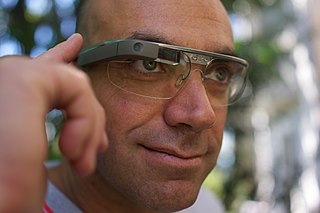 W
WSmartglasses or smart glasses are wearable computer glasses that add information alongside or to what the wearer sees. Alternatively, smartglasses are sometimes defined as wearable computer glasses that are able to change their optical properties at runtime. Smart sunglasses which are programmed to change tint by electronic means are an example of the latter type of smartglasses.
 W
WA smartphone is a mobile device that combines cellular and mobile computing functions into one unit. They are distinguished from feature phones by their stronger hardware capabilities and extensive mobile operating systems, which facilitate wider software, internet, and multimedia functionality, alongside core phone functions such as voice calls and text messaging. Smartphones typically contain a number of metal–oxide–semiconductor (MOS) integrated circuit (IC) chips, include various sensors that can be leveraged by their software, and support wireless communications protocols.
 W
WA smartwatch is a wearable computer in the form of a watch; modern smartwatches provide a local touchscreen interface for daily use, while an associated smartphone app provides for management and telemetry. While early models could perform basic tasks, such as calculations, digital time telling, translations, and game-playing, 2010s smartwatches have more general functionality closer to smartphones, including mobile apps, a mobile operating system and WiFi/Bluetooth connectivity. Some smartwatches function as portable media players, with FM radio and playback of digital audio and video files via a Bluetooth headset. Some models, called watch phones, have mobile cellular functionality like making calls.
 W
WSybase iAnywhere, is a subsidiary of Sybase specializing in mobile computing, management and security and enterprise database software. SQL Anywhere, formerly known as SQL Anywhere Studio or Adaptive Server Anywhere (ASA), is the company's flagship relational database management system (RDBMS). SQL Anywhere powers popular applications such as Intuit, Inc.'s QuickBooks, and the devices of 140,000 census workers during the 2010 United States Census. The product's customers include Brinks, Kodak, Pepsi Bottling Group (PBG), MICROS Systems, Inc. and the United States Navy. In August 2008.
 W
WTegra is a system on a chip (SoC) series developed by Nvidia for mobile devices such as smartphones, personal digital assistants, and mobile Internet devices. The Tegra integrates an ARM architecture central processing unit (CPU), graphics processing unit (GPU), northbridge, southbridge, and memory controller onto one package. Early Tegra SoCs are designed as efficient multimedia processors, while more recent models emphasize performance for gaming and machine learning applications, without sacrificing power efficiency.
 W
WUbuntu Netbook Edition (UNE), known as Ubuntu Netbook Remix (UNR) prior to the release of Ubuntu 10.04, is a discontinued version of the Ubuntu operating system (OS) that had been optimized to enable it to work better on netbooks and other devices with small screens or with the Intel Atom CPU.
 W
WWearable Augmented task-List Interchange Device (W.A.L.I.D) system was designed by computing researchers of the wearable computing group at the University of Oregon as a simulator to test wearable communities projects. The first version was used in testing the Negotiation System described in When Cyborgs Meet: Building Communities of Cooperating Wearable Agents, and as described in Modeling Wearable Negotiation in an Opportunistic Task Oriented Domain. The WALID simulator is also modified for the trust domain.
 W
WA wearable computer, also known as a wearable or body-borne computer, is a computing device worn on the body.
 W
WWindows Mobility Center is a component of Microsoft Windows, introduced in Windows Vista, that centralizes information and settings most relevant to mobile computing.